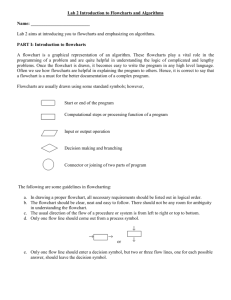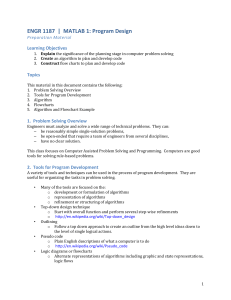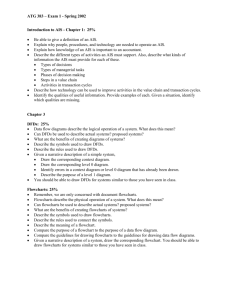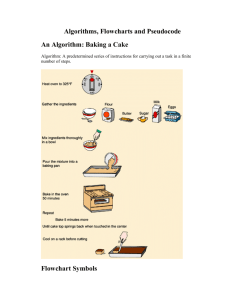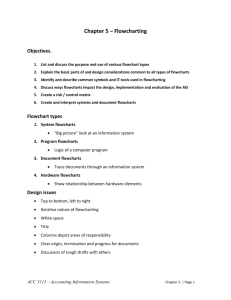Feedback and Flowcharts
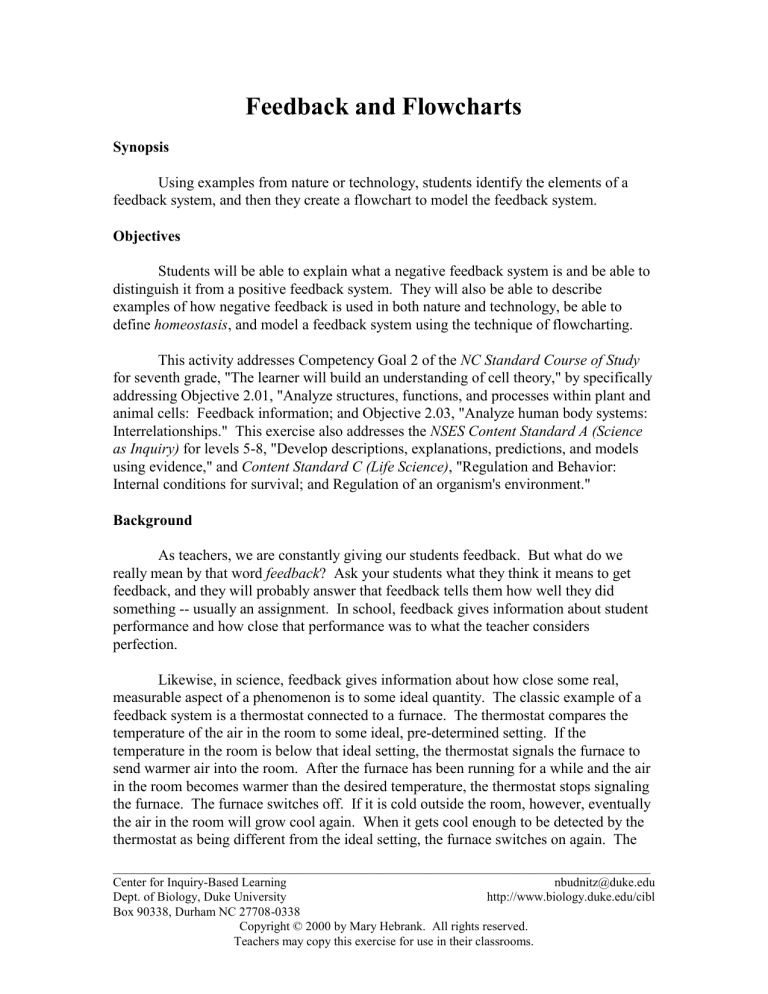
Feedback and Flowcharts
Synopsis
Using examples from nature or technology, students identify the elements of a feedback system, and then they create a flowchart to model the feedback system.
Objectives
Students will be able to explain what a negative feedback system is and be able to distinguish it from a positive feedback system. They will also be able to describe examples of how negative feedback is used in both nature and technology, be able to define homeostasis , and model a feedback system using the technique of flowcharting.
This activity addresses Competency Goal 2 of the NC Standard Course of Study for seventh grade, "The learner will build an understanding of cell theory," by specifically addressing Objective 2.01, "Analyze structures, functions, and processes within plant and animal cells: Feedback information; and Objective 2.03, "Analyze human body systems:
Interrelationships." This exercise also addresses the NSES Content Standard A (Science as Inquiry) for levels 5-8, "Develop descriptions, explanations, predictions, and models using evidence," and Content Standard C (Life Science) , "Regulation and Behavior:
Internal conditions for survival; and Regulation of an organism's environment."
Background
As teachers, we are constantly giving our students feedback. But what do we really mean by that word feedback ? Ask your students what they think it means to get feedback, and they will probably answer that feedback tells them how well they did something -- usually an assignment. In school, feedback gives information about student performance and how close that performance was to what the teacher considers perfection.
Likewise, in science, feedback gives information about how close some real, measurable aspect of a phenomenon is to some ideal quantity. The classic example of a feedback system is a thermostat connected to a furnace. The thermostat compares the temperature of the air in the room to some ideal, pre-determined setting. If the temperature in the room is below that ideal setting, the thermostat signals the furnace to send warmer air into the room. After the furnace has been running for a while and the air in the room becomes warmer than the desired temperature, the thermostat stops signaling the furnace. The furnace switches off. If it is cold outside the room, however, eventually the air in the room will grow cool again. When it gets cool enough to be detected by the thermostat as being different from the ideal setting, the furnace switches on again. The
_____________________________________________________________________________________
Center for Inquiry-Based Learning
Dept. of Biology, Duke University nbudnitz@duke.edu http://www.biology.duke.edu/cibl
Box 90338, Durham NC 27708-0338
Copyright © 2000 by Mary Hebrank. All rights reserved.
Teachers may copy this exercise for use in their classrooms.
Feedback and Flowcharts -- 2 cycle repeats indefinitely, as information about the system’s status is constantly fed back into the system. Because of their cyclical nature, feedback systems are often referred to as feedback loops .
We humans, like all mammals, have a thermostat that keeps our bodies at a constant temperature. The thermostat is located in the hypothalamus (centrally located at the base of the brain), but exactly how it operates is not well understand at this time. We do know that it can trigger either heat-producing or heat-dissipating physiological responses. Shivering or sweating, decreasing or increasing blood flow through the skin, and speeding or slowing the metabolic rate -- all are under control of the hypothalamus and can be adjusted depending on whether the environment we find ourselves in is too cold or too hot for our normal physiology.
Both our technological and physiological feedback systems for maintaining constant temperatures have three key features in common. First, they have in common some sort of sensor that can compare the current status of the system to a desired set point. Second, they both have some sort of mechanism that can respond when there is a difference between the current status and the desired set point. Third, the way they both respond is in a negative manner. By this we mean that the response of the correcting mechanism acts in the opposite direction of the discrepancy between the current status and the desired set point. If the room is too cool, the system responds by starting the furnace in order to raise the temperature. If our bodies are too hot, we start evaporative cooling by sweating in order to lower the temperature. These feedback systems are known as negative feedback systems even though they may cause the temperature to rise
(in a positive direction) or fall (in a negative direction).
Unfortunately, in the language of our modern culture, the word “negative” has become nearly synonymous with “undesirable.” However, the early mathematicians probably never intended for the terms “negative” and “positive” to be judged subjectively; the terms were simply meant to show that one type of number lay in the opposite direction of zero to the other type. Likewise, there is nothing undesirable about a negative feedback system. On the contrary, a negative feedback system is a good thing because it is a self-correcting system. If the system goes too far in one direction, a correction is made in the opposite direction.
Flowcharts are codified, visual representations of steps in a procedure or set of directions. They were originally developed in the computer sciences as a way to outline computer programs prior to actually writing them, just as we use outlines to organize our ideas before writing an essay. Besides being useful tools for programs, flowcharts also provide a good way to create visual models of multi-component systems, including feedback systems.
Flowcharts contain only four types of symbols, three of which are geometric shapes. Ovals, oriented horizontally, are used at the beginning and at the end of a flowchart, to indicate the starting and stopping points of the flowchart procedure.
Feedback and Flowcharts -- 3
Rectangles, also oriented horizontally, indicate the actual steps to be taken. A flowchart may contain many rectangles, but each rectangle may contain only one, discrete step.
Diamonds are used to represent questions that must be answered so that decisions can be made about which steps to take next. Like rectangles, there may be several diamonds in a flowchart, but only one question may be asked at a time. Just as important is the rule that any question asked in a diamond must be capable of being answered by a simple yes or no .
Arrows, which are the fourth type of symbol in a flowchart, indicate the direction of flow of information, or the sequence of activity. The flowchart below shows one student’s method of getting up in the morning.
Procedure
Before modeling feedback systems, students should be able to create simple flowcharts such as the example above. You might want to have each student think of an ordinary activity or procedure, and then create his or her own flowchart that illustrates it.
If students need more guidance, you could write a list of steps on the chalkboard, such as those needed to take an elevator up to another floor:
START
walk to elevator
push the “up” button
wait for the elevator to arrive
is the elevator going up?
walk into the elevator
STOP
Feedback and Flowcharts -- 4
Then, with the class, decide how each step should be represented in a flowchart, while you or a student volunteer draw it on the board. The result should look similar to the one on the left in the diagram below.
Students may want to continue the directions and the flowchart to include arriving at the correct floor and exiting the elevator. In this case, the flowchart will probably look like the one on the right side of the diagram.
Students may have questions about how much detail to include in their flowcharts.
Some may want to include steps such as “move your right foot forward” and “move your left foot forward”, instead of “walk to the elevator”. The important idea of flowcharting
Feedback and Flowcharts -- 5 is that a flowchart forms a practical outline , not a comprehensive set of instructions. As such, it needs to strike a balance between presenting clear, logically ordered steps and being overloaded with excessive details.
Once students are facile with flowcharts, they can begin looking for examples of negative feedback systems, either in nature or in technology. Please give students time to think of examples on their own!! They should also be allowed to check out their ideas with other students. Usually it just takes one or two students to come up with an example before other students will start thinking of similar ones. If students are really struggling, you can mention one or two familiar examples: the way we eat when we feel hungry or drink when we feel thirsty, night-lights and street lights with built-in photocells that turn on when it gets dark, the float-valve system that refills a toilet tank after flushing, a car’s cruise control device, the way information from our eyes helps us keep our balance (try closing your eyes and then standing while holding one foot up behind you), and the light response of the human eye (pupil dilation and contraction). For students that need a challenge, less familiar and more complex examples include most of the cellular functions ( e.g
., the production of enzymes and other proteins) or an airplane’s autopilot system.
Students can make simple flowcharts of feedback systems without knowing very much about the actual sensing devices, how information from the sensors is conveyed to the responding element(s), and/or how the responding elements carry out their responses.
A simple flowchart showing a thermostatically controlled furnace is shown in the figure below. Notice that this flowchart has a starting point but it doesn't have a stopping point.
This is a characteristic of feedback systems -- also known as feedback loops. They start up when the device is turned on, as in a furnace, or when life begins for a biological system. They only stop when the device is turned off, or the organism dies.
Although students can create simple flowcharts such as the one shown above, a few well-directed questions could cause students to find out more about their chosen feedback systems. Access to general reference materials (such as encyclopedias and
Feedback and Flowcharts -- 6 how-things-work types of books) and common technological devices (such as toilets and photocells) can greatly enhance this exercise.
Discussion
Give students a chance to look over each other's flowcharts by posting them on a wall and having students circulate among them. You might want to arrange them by categories, e.g., biological vs.
technological feedback systems. Ask students to count the number of different feedback systems that were modeled in each category. It might also be interesting to see if students can find other groupings or commonalities among the systems. For example, how many are related to temperature, or to volume?
Then ask students what the advantages are of having a negative feedback system.
Most biological and technological mechanisms are specialized and so they are designed to operate within a fairly narrow set of circumstances. For example, chemical reactions within cells, nearly all of which are controlled by enzymes, comprise most of the physiological systems in the human body. Our chemistry operates best at temperatures around 98.6° F. At temperatures in the low 90s some important chemical reactions within our bodies occur too slowly to be effective. On the other hand, at temperatures over 105° some enzymes begin to denature, meaning they loose the three-dimensional shapes that are critical to their functioning. Our bodies, therefore, work best at 98.6°, and our internal thermostat, a negative feedback system, keeps them there in all but the most extreme cases.
Similarly, our cells all need fuel to operate, and our bodies contain several layers of feedback systems to help keep the right amount of glucose circulating in our blood and available to cells that need it. Diabetes is a disease in which part of the feedback loop doesn't function properly due to a lack of the hormone insulin. (This would be a good topic for students to research in the library or on the Internet.)
In general, a feature of all living things is homeostasis , which is the ability to regulate their internal environments to maintain conditions suitable for life. Another way to describe homeostasis is to say it is the ability of an organism to keep its systems in balance even if the environment around it changes somewhat.
Once students have a good understanding of negative feedback systems, ask them what a positive feedback system would do. Can they think of any examples?
Positive feedback systems are usually not a good thing. Imagine an electric blanket for two, divided down the middle, with separate temperature controls for each side (see Figure 4). A man sleeps under one side and his wife sleeps under the other. The wife tends to feel cold at night, so uses her controller to keep the heat turned up high on her half of the blanket. The husband, however, tends to feel warm at night, so he keeps the heat on his side of the blanket turned down low. Normally everyone is happy because
Feedback and Flowcharts -- 7 both parties have control of their sides of the blanket and a pair of negative feedback systems operates side by side.
Now imagine that one night the two controls for the electric blanket get mixed up
(see Figure 5). The husband is under his usual side of the blanket, but somehow, unbeknownst to him, he is holding the control box for his wife’s side. Meanwhile, the wife is under her usual side but is unknowingly holding the control for her husband’s side. The husband, feeling too warm, turns the heat down, but nothing happens to his side -- the blanket is still cranking out heat. So he turns it down some more. Meanwhile, since he was actually turning down the heat on her side of the blanket, the wife feels cold, so she turns up the heat on her controller. But instead of producing more heat, the blanket produces less, so she turns up the heat again. The situation escalates until finally the pair realizes that something is wrong. What is wrong is that they unwittingly created a positive feedback system. When one side of the blanket was too cold, the system responded by making it even colder, and meanwhile, when the other side of the blanket was too hot, the system responded in the same direction -- it made it even hotter.
Feedback and Flowcharts -- 8
Positive feedback systems are sometimes called “vicious cycles” when they produce undesirable effects. The information that is fed back into the system keeps pushing the system in the same direction, and there might not be any way to stop it. In humans, for example, the condition known as hyperthermia , when the body temperature goes above about 105° F, can create a positive feedback system with heat stroke being the disastrous consequence. Hyperthermia occurs when the body’s normal cooling mechanisms are no longer effective, usually due to extremely high environmental temperatures and the dehydration that occurs with excessive sweating. The increase in body temperature that results impairs the hypothalamus, so it no longer signals the heatloss mechanisms that normally operate. With these mechanisms suppressed, the body temperature rises still higher, and with the ensuing heat stroke, permanent brain damage and even death can result. Fortunately, emergency treatment including the administration of fluids and electrolytes, along with immersion in cool water, can interrupt the positive feedback loop.
Acknowledgement
Dr. Steven Vogel, Professor of Zoology at Duke University, first introduced the author of this exercise to feedback systems, including the electric blanket example of positive feedback.

